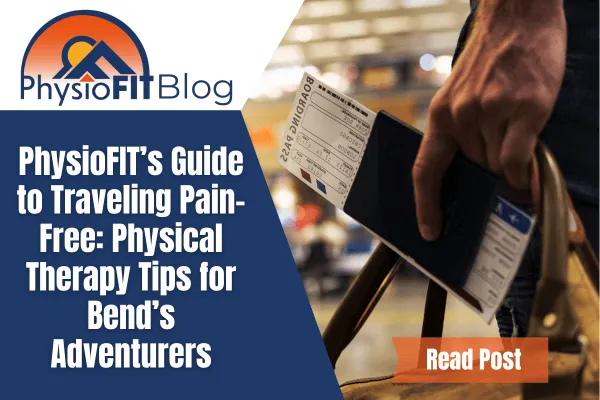Chronic Headache Relief
Free Your Mind From Chronic Headaches
Headaches are an occasional unwelcome guest for many of us, but when they become a frequent visitor, you may be dealing with chronic daily headaches. A broad term that includes various subtypes defined by their frequency and duration. These headaches can be significantly debilitating, but with assertive initial treatment and ongoing management, pain reduction and fewer headaches are achievable. If this strikes a chord with your experience, don't hesitate to schedule an appointment with us.
Discover Unprecedented Relief from Chronic Headaches at PhysioFit: We prioritize personalization in your healthcare journey, acknowledging that individuals with Chronic Headaches necessitate distinct treatment strategies. Utilizing the potency of empirically-supported, fitness-centric physical therapy in bend, we aim to do more than merely alleviate your symptoms. Our mission encompasses the enhancement of your holistic health, prevention of enduring pain, and speeding up your recuperation period, enabling a smooth transition back into your daily routines.
What You Should Know
Migraine headaches can be categorized into two types: episodic and chronic. While chronic migraines happen more than 15 days in a month, episodic ones occur less frequently.
The very medicine you're consuming for headache relief could potentially be causing headaches: Taking pain relievers beyond two days a week, even common ones such as ibuprofen, puts you at risk for what's known as a rebound headache. Similarly, abruptly discontinuing regular pain medication can provoke headaches.
The origin of your headaches may not necessarily be your head: Secondary headaches stem from an underlying health issue, like degenerative disc disease in the spine, sinus infections, or past experiences of head trauma. Although infrequent, persistent headaches and visual disturbances can also be caused by brain tumors.
A proper diagnosis of a TMJ or TMD problem involves a thorough evaluation from a professional.

What Causes Chronic Headaches?
The triggers of numerous chronic daily headaches remain somewhat elusive. Authentic (primary) chronic daily headaches don't present with a detectable root cause.
However, a series of conditions could instigate nonprimary chronic daily headaches, such as:
Vascular Issues: Any inflammation or complications with the blood vessels surrounding or within the brain, including serious events like a stroke, could trigger chronic daily headaches.
Infectious Diseases: Certain infections, notably meningitis, can also result in the manifestation of chronic daily headaches.
Intracranial Pressure Discrepancies: Abnormally high or low pressure within the skull could prompt these types of headaches.
Presence of a Brain Tumor: Brain tumors, whether malignant or benign, could be a potential cause of chronic daily headaches due to the pressure they exert on surrounding brain tissue.
Traumatic Brain Injury: Traumatic events causing injury to the brain can also be a catalyst for chronic daily headaches, as the brain recovers and copes with the trauma.
If any of this information resonates with your current situation, we urge you to schedule an appointment with us immediately. Don't let hip pain diminish your life quality - allow us to help you embark on the path to relief today.
Can Chronic Headaches Be Prevented?
The short answer is yes, chronic headaches can often be prevented, or at least their frequency and intensity can be significantly reduced. The following strategies focus on lifestyle changes and self-care measures which can help you manage and potentially prevent chronic headaches:
Identify Headache Triggers: Proactively documenting each headache in a journal can highlight patterns and triggers, thereby helping you to avoid these. Make sure to record important details like the time the headache started, what you were doing, and how long it lasted.
Cautious Medication Usage: Excessive consumption of headache medications, including over-the-counter ones, can increase the severity and frequency of headaches. It's advisable to consult your doctor for a safe plan to gradually reduce medication use, as abrupt discontinuation can lead to severe side effects.
Quality Sleep: For an average adult, 7-8 hours of sleep a night is essential. Try to maintain a consistent sleep schedule and seek medical advice if you have sleep disturbances, such as snoring.
Regular, Balanced Meals: Aim to eat healthy meals at consistent times daily. Be mindful of potential food and drink triggers like caffeine, and adjust your diet accordingly. Weight loss should be considered if obesity is a concern.
Regular Exercise: Engage in routine aerobic activities to improve your physical and mental well-being and reduce stress. Choose enjoyable activities like walking, swimming, or cycling, and remember to gradually increase the intensity to prevent injury.
Stress Management: Stress can often trigger chronic headaches. Incorporate stress-reducing techniques into your routine such as yoga, tai chi, and meditation. Moreover, staying organized, planning ahead, and maintaining a positive outlook can greatly help in managing stress.
Moderate Caffeine Intake: While caffeine is included in many headache medications due to its pain-alleviating properties, it can also exacerbate headaches. Try to reduce or completely remove caffeine from your diet.

Common Symptoms of Chronic Headaches
Chronic daily headaches, as the name implies, occur more than half the month, lasting for a period exceeding three months. Primary chronic daily headaches are those not precipitated by any underlying health condition.
These headaches can be of shorter or longer duration. Those falling in the long-lasting category persist for over four hours. The types of long-lasting chronic headaches encompass:
Persistent Migraines
Continuous Tension-Type Headache
Newly Appearing Daily Persistent Headache
Hemicrania Continua
Remember, if you resonate with any of the symptoms or conditions mentioned, we highly recommend making an appointment with us for a thorough evaluation and personalized treatment plan.
Please Note: The information provided on our website is intended for general education and is not a substitute for professional medical advice. Each individual's situation and body is different. Therefore, what may work for one person may not work for another. We care about your well-being and advise you to reach out to us to discuss your specific needs before implementing any advice from our website.
Your Source for All Things Physical Therapy in Bend Oregon
The PhysioBlog

PhysioFIT’s Guide to Traveling Pain-Free: Physical Therapy Tips for Bend’s Adventurers
Please Note: The information provided on our website is intended for general education and is not a substitute for professional medical advice. Each individual's situation and body are different. Therefore, what may work for one person may not work for another. We care about your well-being and advise you to reach out to us to discuss your specific needs before implementing any advice from our website. If you’d like to explore this more or would like to schedule a time with a physical therapist in Bend Oregon, contact us at PhysioFITBend.com
Introduction
PhysioFIT presents a comprehensive guide for travelers seeking to avoid pain. Learn how to travel pain-free with tips from our experts. Discover the techniques and strategies that will ensure a comfortable and enjoyable journey.
Packing Tips for Travelers
When it comes to traveling pain-free, proper packing plays a crucial role. In this guide, we'll share some invaluable tips to ensure a comfortable and pain-free travel experience.
One key aspect to consider is choosing the right suitcase. It's essential to select a suitcase that suits your travel needs and provides adequate support for your belongings. By understanding the importance of suitcase selection, you can make informed choices and alleviate any potential strain and discomfort while on the move.
Choosing the Right Suitcase
When it comes to selecting the appropriate baggage for your journey, opt for a suitcase that suits your needs. Consider various factors such as size, weight, durability, and maneuverability.
Suitcase size should be suitable for the duration of your trip and the amount of belongings you plan to bring.
Weight is an important consideration, as a heavier suitcase can be burdensome to carry and potentially exceed airline weight restrictions.
Durability is crucial to ensure that your belongings are protected during transit, especially if you are traveling long distances or encountering rough handling.
Maneuverability refers to the ease of moving your suitcase around. Features such as wheels and handles play a crucial role in making transportation more convenient.
Additionally, keep in mind other specific requirements you may have, such as whether the suitcase has compartments for organization or if it meets carry-on regulations. By carefully considering these factors, you can make an informed decision when choosing the right suitcase for your travels.
A unique detail worth mentioning is that some suitcases come with innovative features like built-in chargers or GPS tracking devices. These additional functionalities can provide extra convenience and security during your journey.
Taking Care of Your Body During Travel
When it comes to traveling, taking care of your body is crucial to ensure a pain-free journey. In this section, we will explore two essential aspects that contribute to keeping your body in good shape while you're on the go.
First, we will delve into the importance of staying active during your travels and how it can benefit your overall well-being.
Additionally, we’ll discuss the significance of supporting your body with good shoes, offering practical tips to help prevent common foot and leg issues.
So, let's dive in and learn how to maintain a healthy body while exploring new destinations.
Staying Active
To stay active during your travels, it's important to keep your body moving and engaged. Engage in physical activities that keep your muscles and joints active and flexible. This will help prevent stiffness, muscle fatigue, and potential injuries that can occur from prolonged periods of sitting or inactivity. Remember to prioritize movement throughout your journey to ensure a pain-free and enjoyable travel experience.
Find opportunities to stretch or move whenever possible, whether it's during layovers or while waiting for transportation. Take short walks, do some light stretching exercises, or try simple movements like shoulder rolls or ankle flexes. Keeping your body in motion will help improve circulation, reduce muscle tension, and alleviate any discomfort caused by prolonged sitting.
In addition to these activities, consider incorporating strength training exercises into your routine. This will help build muscle strength and endurance, which are essential for maintaining good posture and preventing muscular imbalances. You can do bodyweight exercises such as squats or lunges, or use resistance bands for added resistance.
Lastly, don't forget the importance of proper hydration and nutrition when staying active during travel. Drink plenty of water to stay hydrated and choose nutritious snacks that provide sustained energy throughout the day.
By staying active during your travels, you can maintain a healthy body and mind while enjoying all the adventures that await you. Embrace opportunities for movement and make it a priority to incorporate physical activity into your travel plans.
Supporting Your Body with Good Shoes
Wearing the right shoes plays a crucial role in supporting your body while traveling. Here are 5 key points to consider when supporting your body with good shoes:
Choose shoes that provide adequate arch support to maintain proper alignment of your feet and minimize strain on the rest of your body.
Opt for shoes with cushioning to absorb shock and reduce impact on joints, helping to prevent injuries and discomfort.
Select shoes made from breathable materials to keep your feet dry and comfortable during long hours of travel.
Look for shoes that offer a secure fit, providing stability and reducing the risk of slips or falls.
Consider packing orthotic inserts if you have specific foot conditions or require additional support.
It’s important to note that supportive footwear is not only beneficial during travel but also in everyday life. Properly supporting your body with good shoes can help alleviate pain, prevent injuries, and promote overall well-being.
Stretching Exercises for Travelers
As a travel enthusiast, I understand the importance of staying pain-free while exploring new destinations. In this part of PhysioFIT’s Guide to Traveling Pain-Free, we will explore a series of stretching exercises specifically designed for travelers like us. These exercises target different areas of the body to alleviate common travel-related discomforts such as neck and upper shoulder pain, headaches, and lower back stiffness. We will also learn how to improve overall mobility and flexibility, focusing on areas like the chest, armpits, and hamstrings. So, let's dive into these stretches and enhance our journey with comfort and ease.
Relieving Neck and Upper Shoulder Pain
Relieving Tension in the Neck and Upper Shoulder Area
Start by employing these four easy steps to relieve tension in the neck and upper shoulder area:
Perform gentle stretching exercises that target these specific areas.
Use heat therapy to relax the muscles.
Practice good posture throughout the day to alleviate strain.
Consider seeking professional help from a physical therapist for targeted treatment options.
In addition to these practical tips, it is important to note that maintaining a regular stretching routine can help prevent future episodes of neck and upper shoulder pain. By incorporating these stretches into your daily routine, you can improve flexibility and reduce the likelihood of experiencing discomfort in this area. It is recommended to consult with a healthcare professional for personalized guidance.
Historically, neck and upper shoulder pain have been common issues faced by individuals who engage in repetitive activities or spend prolonged periods in poor posture positions. As awareness grows about the importance of proper body mechanics and self-care practices, more people are taking proactive steps to alleviate and prevent discomfort in this area. Physical therapists continue to play a crucial role in guiding individuals towards effective pain management strategies for relieving neck and upper shoulder pain.
Relieving Headaches and Neck Pain
There are effective ways to alleviate headaches and neck pain while traveling. One method is engaging in stretching exercises specifically targeting the neck and upper shoulder area. These stretches can help relieve tension and improve flexibility in these areas, ultimately reducing pain.
Additionally, wearing supportive shoes during travel can provide extra cushioning and stability for the body, thereby minimizing strain on the neck and reducing the likelihood of headaches. By incorporating these strategies into your travel routine, you can alleviate headaches and neck pain for a more comfortable journey.
Improving Mobility in the Lower Back
Improving mobility in the lower back can be achieved through specific exercises and stretches that target the muscles and ligaments in this area. By incorporating these exercises into your routine, you can increase flexibility, reduce pain, and improve your overall spinal health.
Start with gentle stretching exercises to warm up the muscles in your lower back.
Engage in low-impact activities such as walking or swimming to strengthen the muscles around your spine.
Incorporate core-strengthening exercises like planks and bridges to provide stability and support for your lower back.
Practice proper posture and body mechanics throughout the day to prevent unnecessary strain on your lower back.
To further enhance your mobility in the lower back, consider seeking professional guidance from a physical therapist or chiropractor who can provide personalized recommendations based on your specific needs. They can help identify any underlying issues or imbalances that may be contributing to your pain or limited mobility.
By taking proactive steps to improve mobility in the lower back, you can reduce the risk of injury, alleviate discomfort, and enjoy a more active and pain-free lifestyle.
Stretching the Hamstrings
To improve flexibility and prevent injuries, it is important to focus on stretching the muscles in the back of the thigh known as the hamstrings. Follow these steps for an effective hamstring stretch:
Stand upright with one leg extended forward and the other leg positioned slightly behind you.
Keep your back straight and slowly bend forward from your hips, reaching towards your toes with both hands.
Hold this position for 20-30 seconds, feeling a gentle stretch in the back of your thigh.
While performing this stretch, remember to breathe deeply and avoid bouncing or jerking movements that can strain the muscles. It is recommended to repeat this stretch several times on each leg.
To maximize the benefits of stretching the hamstrings, ensure proper form and technique to avoid injury. Remember to consult a healthcare professional if you experience any pain or discomfort while performing these exercises.
Feel confident in taking care of your body during travel by incorporating hamstring stretches into your routine. Don't miss out on enhancing your mobility and preventing muscle tightness by neglecting this important exercise.
Conclusion
Traveling is an exhilarating experience, offering a chance to explore new horizons and create lasting memories. However, the physical demands of travel can sometimes take a toll on our bodies. From the strain of carrying luggage to the prolonged periods of sitting, it's essential to prioritize our well-being during our journeys.
The key to a pain-free travel experience lies in preparation and awareness. Investing in the right suitcase, understanding its significance, and knowing how to pack efficiently can make a world of difference. But beyond our luggage, it's our body that needs the utmost care. Staying active, wearing the right shoes, and incorporating regular stretches can alleviate common travel-related discomforts.
PhysioFIT's comprehensive guide underscores the importance of understanding our body's needs while traveling. From the nuances of choosing the right suitcase to the significance of stretching exercises tailored for travelers, the guide offers a holistic approach to traveling pain-free. The emphasis on the physical and mental aspects of travel ensures that travelers are equipped with the knowledge and tools to navigate their journeys with ease and comfort.
In essence, traveling doesn't have to be synonymous with discomfort. With the right strategies, guidance from experts like PhysioFIT, and a proactive approach, you can ensure that your travels are not only memorable but also comfortable. So, as you pack your bags for your next adventure, remember to also pack in the wisdom from this guide. Prioritize your well-being, embrace the stretches, and let every journey be a testament to traveling pain-free. Safe travels!
Five Facts For Traveling Pain-Free
✅ Over-packing can lead to a heavier suitcase, increasing the risk of injury during travel.
✅ Using smaller suitcases can help distribute the load and make lifting easier, especially when traveling by car.
✅ Packing supportive shoes can help prevent aches and pains associated with increased activity during travel.
✅ Regular movement is essential to prevent stiffness and promote blood flow during travel. Take breaks to stretch and walk around.
✅ Performing simple stretches for the neck, shoulders, chest, low back, and legs can help alleviate pain and discomfort during travel.
Please Note: It's important to note that any exercises or techniques that are shared should be performed under the guidance of a qualified bend physical therapy expert to ensure correct technique and to prevent injuries. A physical therapist can provide a customized exercise program based on the individual's fitness level, goals, and any existing injuries or conditions. If you’d like to explore this more or would like to schedule a time with a physical therapist in Bend Oregon, contact us atPhysioFITBend.com
Copyright PhysioFIT 2025 . All rights reserved


